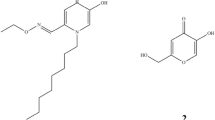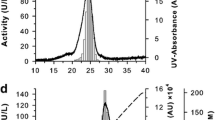Abstract
The oxygen-transporting protein, hemocyanin (Hc), of the garden snail Helix aspersa maxima (HaH) was isolated and kinetically characterized. Kinetic parameters of the reaction of catalytic oxidation of catechol to quinone, catalyzed by native HaH were determined: the V max value amounted to 22 nmol min−1 mg−1, k cat to 1.1 min−1. Data were compared to those reported for other molluscan Hcs and phenoloxidases (POs). The o-diphenoloxidase activity of the native HaH is about five times higher than the activity determined for the Hcs of the terrestrial snail Helix pomatia and of the marine snail Rapana thomasiana (k cat values of 0.22 and 0.25 min−1, respectively). The K m values obtained for molluscan Hcs from different species are comparable to those for true POs, but the low catalytic efficiency of Hcs is probably related to inaccessibility of the active sites to potential substrates. Upon treatment of HaH with subtilisin DY, the enzyme activity against substrate catechol was considerably increased. The relatively high proteolytically induced o-diPO activity of HaH allowed using it for preparation of a biosensor for detection of catechol.









Similar content being viewed by others
Abbreviations
- DMF:
-
N,N-dimethylformamide
- l-Dopa:
-
3,4-Dihydroxy-l-phenyl-alanine
- EDTA:
-
Ethylenediaminetetraacetic acid
- MBTH:
-
3-Methyl-2-benzothiazolinone hydrazone
- PAGE:
-
Polyacrylamide gel electrophoresis
- PMSF:
-
Phenylmethanesulfonyl fluoride
- SDS:
-
Sodium dodecyl sulphate
- Tris–HCl:
-
Tris (hydroxymethyl) amino-methane hydrochloride
References
Abdullah J, Ahmad M, Karuppiah N, Heng LY, Sidek H (2006) Immobilization of tyrosinase in chitosan film for an optical detection of phenol. Sens Actuators B: Chem 114:604–609
Abdullah J, Ahmad M, Heng LY, Karuppiah N, Sidek H (2007) An optical biosensor based on immobilization of laccase and MBTH in stacked films for the detection of catechol. Sensors 7:2238–2250
Campello S, Beltramini M, Giordano G, Di Muro P, Marino SM, Bubacco L (2008) Role of the tertiary structure in the diphenol oxidase activity of Octopus vulgaris hemocyanin. Arch Biochem Biophys 471:159–167
Decker H, Tuczek F (2000) Tyrosinase/catecholoxidase activity of hemocyanins: structural basis and molecular mechanism. Trends Biochem Sci 25:392–397
Decker H, Jaenicke E (2004) Recent findings on phenoloxidase activity and antimicrobial activity of hemocyanins. Dev Comp Immunol 28:673–687
Dykstra P, Hao J, Koev ST, Payne GF, Yu L, Ghodssi R (2009) An optical MEMS sensor utilizing a chitosan film for catechol detection. Sens Actuators B: Chem 138:64–70
Eicken C, Zippel F, BuEldt-Karentzopoulos K, Krebs B (1998) Biochemical and spectroscopic characterization of catechol oxidase from sweet potatoes (Ipomoea batatas) containing a type 3 dicopper center. FEBS Lett 436:293–299
Espin JC, Morales M, Varon R, Tudela J, Garcia-Canovas F (1995) A continuous spectrophotometric methods for determining monophenolase and diphenolase activities of apple polyphenol oxidase. Anal Biochem 231:237–246
Gielens C, Verschueren LJ, Preaux G, Lontie R (1981) Gel chromatographic separation of the hemocyanins of Helix pomatia. Further electrophoretic and immunological characterization of the components. Comp Biochem Physiol 69B:455–462
Gielens C, De Sadeleer J, Preaux G, Lontie R (1987) Identification, separation and characterization of the hemocyanin components of Helix aspersa. Comp Biochem Physiol 88B:181–186
Heirwegh K, Borginon H, Lontie R (1961) Separation and absorption spectra of α- and β-hemocyanin of Helix pomatia. Biochim Biophys Acta 48:517–526
Hristova R, Dolashki A, Voelter W, Stefanovic S, Dolashka-Angelova P (2008) o-Diphenol oxidase activity of molluscan hemocyanins. Comp Biochem Physiol 149B:439–446
Idakieva K, Siddiqui NI, Parvanova K, Nikolov P, Gielens C (2006) Fluorescence properties and conformational stability of the β-hemocyanin of Helix pomatia. Biochim Biophys Acta 1764:807–814
Idakieva K, Nikolov P, Chakarska I, Shnyrov VL, Genov N (2008) Spectroscopic properties and conformational stability of Concholepas concholepas hemocyanin. J Fluoresc 18:715–725
Idakieva K, Siddiqui NI, Meersman F, De Maeyer M, Chakarska I, Gielens C (2009) Influence of limited proteolysis, detergent treatment and lyophilization on the phenoloxidase activity of Rapana thomasiana hemocyanin. Int J Biol Macromol 45:181–187
Jung CT, Wickett RR, Desai PL, Bronaugh RL (2003) In vitro and in vivo percutaneous absorption of catechol. Food Chem Toxicol 41:885–895
Laemmli UK (1970) Cleavage of structural proteins during the assembly of the head of bacteriophage T4. Nature 227:680–685
Lontie R (1983) Components, functional units, and active sites of Helix pomatia hemocyanin. Life Chem Rep Suppl 1:109–120
Naraoka T, Uchisawa H, Mori H, Matsue H, Chiba S, Kimura A (2003) Purification, characterization and molecular cloning of tyrosinase from the cephalopod mollusk, Illex argentinus. Eur J Biochem 270:4026–4038
Naresh KN, Krupanidhi S, Rajan SS (2013) Purification, spectroscopic characterization and o-diphenoloxidase activity of hemocyanin from a freshwater gastropod: Pila globosa. Protein J 32:327–336
Paranjpe P, Dutta S, Karve M, Padhye S, Narayanaswamy R (2001) A disposable optrode using immobilized tyrosinase films. Anal Biochem 294:102–107
Perbandt M, Guthöhrlein E, Rypniewski W, Idakieva K, Stoeva S, Voelter W, Genov N, Betzel C (2003) The structure of a functional unit from the wall of a gastropod hemocyanin offers a possible mechanism for cooperativity. Biochemistry 42:6341–6346
Préaux G, Gielens C (1984) In: Lontie R (ed) Copper proteins and copper enzymes, vol II. CRC Press, Boca Raton
Salvato B, Santamaria M, Beltramini M, Alzuet G, Casella L (1998) The enzymatic properties of Octopus vulgaris hemocyanin: o-diphenol oxidase activity. Biochemistry 37:14065–14077
Siddiqui NI, Akosung RF, Gielens C (2006) Location of intrinsic and inducible phenoloxidase activity in molluscan hemocyanin. Biochim Biophys Res Commun 348:1138–1144
Siddiqui NI, Yigzaw Y, Preaux G, Gielens C (2009) Involvement of glycans in the immunological cross-reaction between α-macroglobulin and hemocyanin of the gastropod Helix pomatia. Biochimie 91:508–516
Solomon EI, Tuczek F, Root D, Brown C (1994) Spectroscopy of binuclear dioxygen complexes. Chem Rev 94:827–856
Solomon EI, Sundaram UM, Machonkin TE (1996) Multicopper oxidases and oxygenases. Chem Rev 96:2563–2606
Starek A (2003) Estrogens and organochlorine xenoestrogens and breast cancer risk. IJOMEH 16:113–124
Suzuki K, Shimokawa C, Morioka C, Itoh S (2008) Monooxygenase activity of Octopus vulgaris hemocyanin. Biochemistry 47:7108–7115
van Holde K, Miller K, Decker H (2001) Hemocyanins and invertebrate evolution. J Biol Chem 276:15563–15566
Velkova L, Dimitrov I, Schwarz H, Stefanovic S, Voelter W, Salvato B, Dolashka-Angelova P (2010) Structure of hemocyanin from garden snail Helix lucorum. Comp Biochem Physiol B 157:16–26
Wang G, Xu JJ, Ye LH, Zhu JJ, Chen HY (2002) Highly sensitive sensors based on the immobilization of tyrosinase in chitosan. Bioelectrochemistry 57:33–38
Wang S, Tan Y, Zhao D, Liu G (2008) Amperometric tyrosinase biosensor based on Fe3O4 nanoparticles-chitosan. Biosens Bioelectron 23:1781–1787
Wang B, Zheng J, He Y, Sheng Q (2013) A sandwich-type phenolic biosensor based on tyrosinase embedding into single-wall carbon nanotubes and polyaniline nanocomposites. Sens Actuators B: Chem 186:417–422
Yang D-P, Ji H-F, Tang G-Y, Ren W, Zhang H-Y (2007) How many drugs are catecholics. Molecules 12:878–884
Yang L, Xiong H, Zhang X, Wang S (2012) A novel tyrosinase biosensor based on chitosan-carbon-coated nickel nanocomposite film. Bioelectrochemistry 84:44–48
Yinges Y, Gielens C, Preaux G (2001) Isolation and characterization of an α-macroglobulin from the gastropod mollusc Helix pomatia with tetrameric structure and preserved activity after methylamine treatment. Biochim Biophys Acta 1545:104–113
Zhang J, Lei J, Liu Y, Zhao J, Ju H (2009) Highly sensitive amperometric biosensors for phenols based on polyaniline-ionic liquid-carbon nanofiber composite. Biosens Bioelectron 24:1858–1863
Acknowledgments
We are grateful to the National Science Fund of the Ministry of Education, Youth and Science, Bulgaria, for the financial support of a research Grant DTK 02/78.
Author information
Authors and Affiliations
Corresponding author
Rights and permissions
About this article
Cite this article
Raynova, Y., Doumanova, L. & Idakieva, K.N. Phenoloxidase Activity of Helix aspersa Maxima (Garden Snail, Gastropod) Hemocyanin. Protein J 32, 609–618 (2013). https://doi.org/10.1007/s10930-013-9523-0
Published:
Issue Date:
DOI: https://doi.org/10.1007/s10930-013-9523-0




